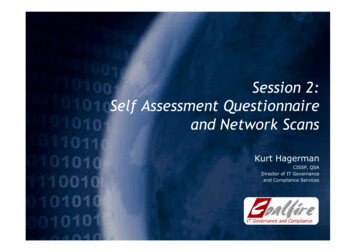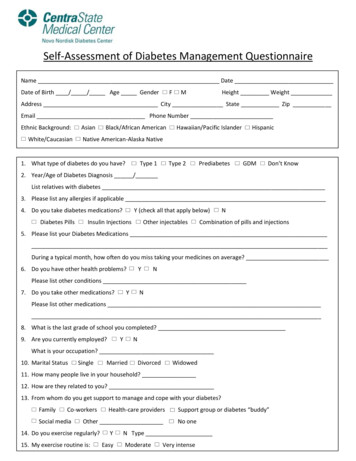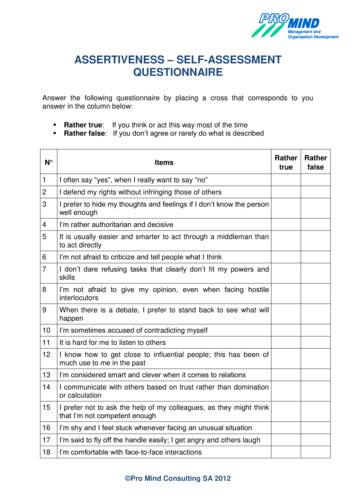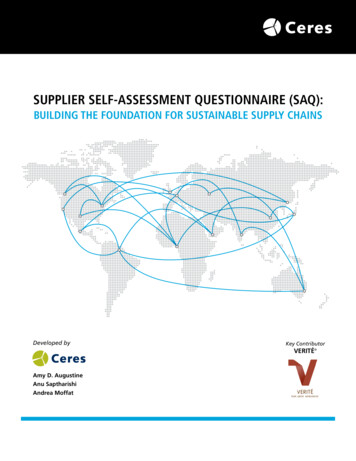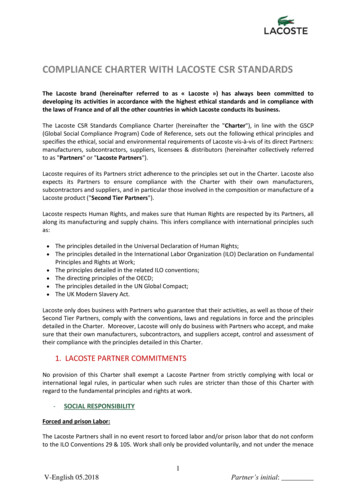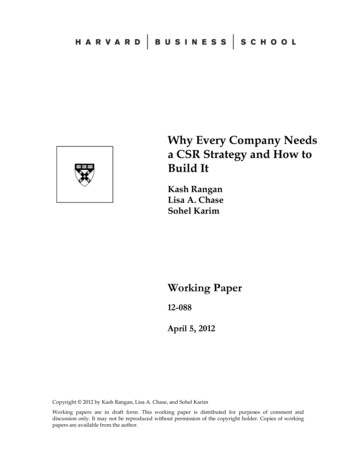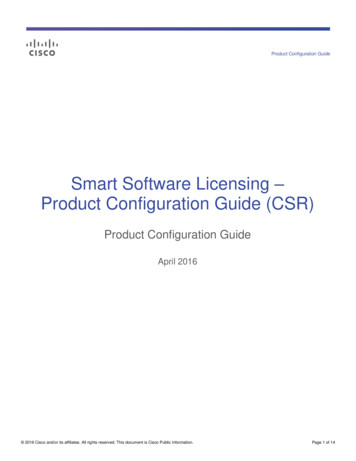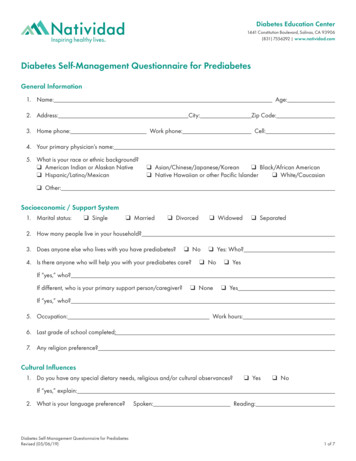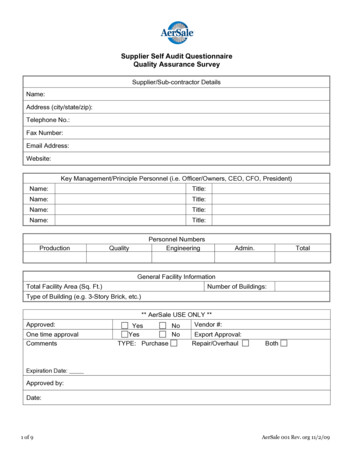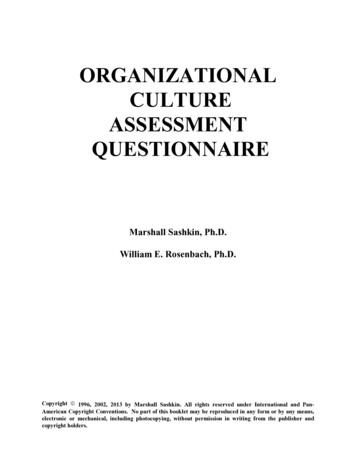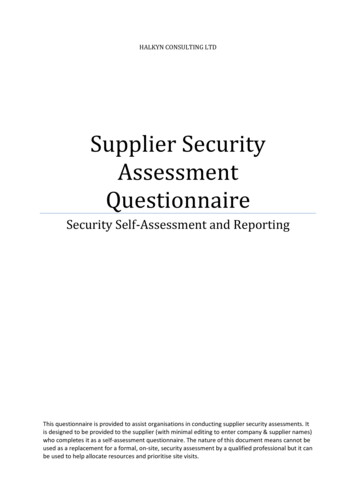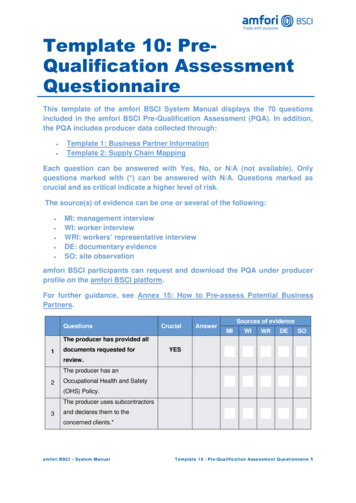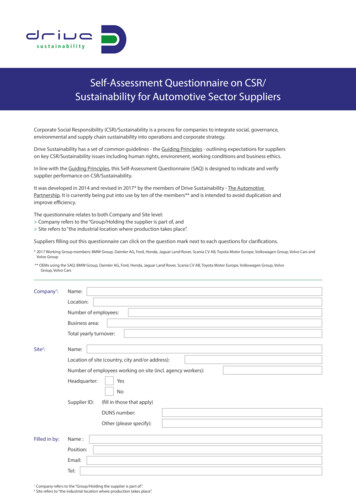
Transcription
Self-Assessment Questionnaire on CSR/Sustainability for Automotive Sector SuppliersCorporate Social Responsibility (CSR)/Sustainability is a process for companies to integrate social, governance,environmental and supply chain sustainability into operations and corporate strategy.Drive Sustainability has a set of common guidelines - the Guiding Principles - outlining expectations for supplierson key CSR/Sustainability issues including human rights, environment, working conditions and business ethics.In line with the Guiding Principles, this Self-Assessment Questionnaire (SAQ) is designed to indicate and verifysupplier performance on CSR/Sustainability.It was developed in 2014 and revised in 2017* by the members of Drive Sustainability - The AutomotivePartnership. It is currently being put into use by ten of the members** and is intended to avoid duplication andimprove efficiency.The questionnaire relates to both Company and Site level: Company refers to the “Group/Holding the supplier is part of, and Site refers to “the industrial location where production takes place”.Suppliers filling out this questionnaire can click on the question mark next to each questions for clarifications.* 2017 Working Group members: BMW Group, Daimler AG, Ford, Honda, Jaguar Land Rover, Scania CV AB, Toyota Motor Europe, Volkswagen Group, Volvo Cars andVolvo Group** OEMs using the SAQ: BMW Group, Daimler AG, Ford, Honda, Jaguar Land Rover, Scania CV AB, Toyota Motor Europe, Volkswagen Group, VolvoGroup, Volvo CarsCompany1:Name:Location:Number of employees:Business area:Total yearly turnover:Site2:Name:Location of site (country, city and/or address):Number of employees working on site (incl. agency workers):Headquarter:Supplier ID:YesNo(fill in those that apply)DUNS number:Other (please specify):Filled in by:Name :Position:Email:Tel:12Company refers to the “Group/Holding the supplier is part of”.Site refers to “the industrial location where production takes place”.
A. COMPANY MANAGEMENT (GENERAL)BACKGROUND INFORMATION1a. Does your company have a Social Sustainabilityresponsible management person?*Social sustainability relates to practices thatcontribute to the quality of life of both employeesand communities that could be impacted by thecompany’s operations. Companies should respectthe human rights of workers, and treat all peoplewith dignity as recognised by the internationalcommunity. Examples of social topics to addressinclude non-discrimination, freedom of association,health and safety, etc. (See Section B - WorkingConditions and Human Rights) No Yes*, at company levelYes*, at site levelIf yes, please provide:Name :e-mail :Compliance relates to the principles that guidebusiness conduct in its relations towards itsbusiness partners and customers. Companiesare expected to uphold the highest standardsof integrity and to operate honestly andequitably throughout the supply chain inaccordance with local laws. Examples ofunethical business practice include corruption,unfair competition, conflicts of interest, etc.(See Section C - Business Ethics)1b. Does your company have a Compliance responsiblemanagement person?* No Yes*, at company levelYes*, at site levelIf yes, please provide:Name :e-mail :Environmental sustainability relates topractices that contribute to the quality of theenvironment on a longterm basis. Companiesare expected to support a proactive approachto environmental responsibility by protectingthe environment, conserving natural resourcesand reducing the environmental footprintof their production, products and servicesthroughout their life-cycle. Examples ofcompany practices include greenhouse gasemissions, waste reduction programmes, etc.(See Section D - Environment)1c. Does your company have an EnvironmentalSustainability responsible management person?* No Yes*, at company levelYes*, at site levelIf yes, please provide:Name :e-mail :Companies are expected to appoint a seniormanagement representative, who irrespective ofother responsibilities, serves as a managementperson responsible for ensuring that thecompany meets its commitment related to socialsustainability, business ethics and environmentalsustainability.* Please fill out the contact details, even if the person is the same as above.The contact details that you provide inresponse to this question will not be contactedwithout prior notice. In the first instance,enquiries will be directed to the person thatcompletes this self-assessment questionnaire.2
A. COMPANY MANAGEMENT (GENERAL)BACKGROUND INFORMATION2. Does your company publish a CSR/SustainabilityReport?A CSR/ sustainability report isan organisational report that gives informationabout economic, environmental, social andethical performance.NoYes, according to GRI standardsExamples of internationally recognisedstandards and frameworks for CSR/sustainability report are: Global Reporting Initiative (GRI) Standards; Sustainability Accounting Standards Board(SASB); Climate Disclosure Standards Board (CDPCDSB); United Nations Global Compact Communication on Progress (UNGC-COP).Please upload report Yes, according to other globally acceptedstandards Please provide the name of the globally acceptedstandardPlease upload report2a. Is your most recent report assured by a third party?In the European Union, EU Directive onNon-Financial and Diversity InformationDisclosure lays down the rules on disclosureof non-financial and diversity information forcompanies with operations in EU MemberStates that meet all of the following criteria:NoYes If yes, please provide the name of thethird party and the assurance letter:2b. A re the operations of all your company sitesincluded in that report?1. Your company is a large undertaking (in themeaning of Art. 3 (7) of Directive 2013/34/EU) with either a balance sheet total of EUR20 million OR a net turnover EUR 40 million.NoYes2. A ND your company is a public interestentity, defined by Art. 2 (a, b, c, d) ofDirective 2013/34/EU,3. A ND when your company’s average numberof employees exceeds 500 during a financialyear.3. Does your company have a Code of Conduct in place?A Code of Conduct is a set of rules outliningthe responsibilities or proper practice foran individual (employee) and organisation.It could cover social, ethical and environmentalaspects.No YesPlease upload relevant document3a. Is the Code of Conduct in place for this site?NoYes3
A. COMPANY MANAGEMENT (GENERAL)BACKGROUND INFORMATION4. Do you organise training sessions to enhance theunderstanding of CSR/ Sustainability?Training sessions to enhance theunderstanding of CSR/ Sustainability refer tocompanies training their employees on theexpectations, policies and procedures relatingto Corporate Social Responsibility within thecompany context.NoYes, at site levelYes, at company levelTraining is intended to raise awareness on CSR/ Sustainability topics, so that specific functionscan identify and act on issues they encounterin their day-to-day activities.4a. If answered yes, on which of the following topics doyour organise training sessions?Business Ethics Please upload evidenceEnvironmentWorking Conditions and Human RightsPlease upload evidencePlease upload evidenceExamples of CSR / sustainability issues thatcompanies could conduct training sessionson are included in the Global AutomotiveSustainability Guiding Principles4b. If answered yes, what is the frequency of thetraining sessions?Training could be function-specific (e.g.training for buyers, managers, etc.), or topicspecific (e.g. on human rights, anti-corruption,Health&Safety, chemical management etc.)Please specifyOPTIONAL5. H ave employees from this site participated in externalCSR/ Sustainability training?NoYes5a. If answered “Yes”, Who organised the training? An OEMPlease specify: (Month/Year) The Automotive Industry Action Group (AIAG)Please specify: (Month/Year) Drive SustainabilityPlease specify: (Month/Year)Other (please specify)OPTIONALVoluntary CSR/ sustainability initiatives can befor example United Nations Global Compact- UNGC, CDP - Carbon Disclosure Project, orindustry specific initiatives6. Does your company participate in any voluntary CSR/sustainability initiatives?Yes (please specify)No4
B. WORKING CONDITIONS AND HUMAN RIGHTSBACKGROUND INFORMATION7. For which of the following working conditions and humanrights issues does your company have a policy in place?A company policy refers to a businessapproach to a given issue and contains generalprinciples and/or practical how-to-do items.A policy may include components such asprohibited behaviours, rights, and disputeprocedures. Social issues could be containedin the company CSR policy, HR policy, HumanRights policy, etc. The list here presentedrefers to the Global Automotive SustainabilityGuiding PrinciplesChild labour and Young WorkersWages and BenefitsWorking hoursForced or compulsory labour and human traffickingFreedom of association and collective bargainingHealth and SafetyHuman rights are the rights we are entitledto simply because we are human beings. Theyrepresent the universally agreed minimumconditions that enable all people to maintaintheir dignity. Human rights are inherentto all of us, whatever our nationality, placeof residence, sex, national or ethnic origin,colour, religion, or any other status.HarassmentNon-discriminationplease upload relevant document7a. Does your company use any of the followingchannels to communicate its Policy to employees?Source: Universal Declaration of Human Rights Intranet / Meetings / Brochures, etc.Please upload relevant documentsChild labour and Young Workers relate tothe prohibition of employment of children whoare under the legal minimum working age.Moreover, suppliers are expected to ensurethat legally young workers that are under18 years of age do not work at night orovertime and are protected against conditionsof work which are harmful for their health,safety or development consistent with ILOMinimum Age Convention No. 138. ILO 138light work consistent (article 6,7). The suppliershould ensure that young workers duties don’tinterfere with their school attendance. Youngworkers daily total duty time and schoolingshall not exceed 10 h. TrainingPlease upload relevant documents Others (please specify):Please upload relevant documentsSource: EU Charter of Fundamental Rights & ILOWages & benefits relate to the basic orminimum wage or salary and any additionalentitlements payable directly or indirectly, incash or in kind, by the employer to the workerand arising out of the worker’s employment.Examples include paid sick days, family andmedical leave, paid overtime, etc.Source: ILO-UNGC.Working hours relate to regular workweeksthat should not exceed 48 hours. A workweekshall be restricted to 60 hours in emergencysituations, including overtime. All overtimeshall be voluntary. Employees should haveminimum one day off every seven days. Lawsand regulations on maximum number ofworking hours and time off shall be respected.Source: Ethical Trading Initiative, based on ILO conventions5
B. WORKING CONDITIONS AND HUMAN RIGHTSBACKGROUND INFORMATIONForced or compulsory labour refers to allwork or service exacted from any personunder the menace of any penalty and forwhich that person has not offered himselfvoluntarily. Examples include forced overtime,retention of identity documents, as well ashuman trafficking.Human trafficking - also called “modernslavery” - is subject to the Modern Slavery Act2015 by the Parliament of the United Kingdom.This Act creates for companies who meetidentified criteria an obligation to publish a“slavery and human trafficking statement”every year six months after the end of thecompany’s financial year.Source: International Labour Organisation (ILO) & The NationalArchives UKFreedom of association relates to the right tofreedom of peaceful assembly and to freedomof association at all levels, in particular inpolitical, trade union and civic matters, whichimplies the right of everyone to form and tojoin trade unions for the protection of hisor her interests. This includes also collectivebargaining, as a process of negotiationsbetween employers and a group of employeesaimed at reaching an agreement that regulatesworking conditions.Source: EU Charter of Fundamental RightsHealth & Safety refers to the science of theanticipation, recognition, evaluation andcontrol of hazards arising in orfrom the workplace that could impair thehealth and well-being of workers, takinginto account the possible impact on thesurrounding communities and the generalenvironment.Source: ILOHarassment is defined as a harsh andinhumane treatment - or the threat of such antreatment - including any sexual harassment,sexual abuse, corporal punishment, mental orphysical coercion or verbal abuse of workers.Source: Global Automotive Sustainability Practical GuidanceNon-discrimination is a principle thatrequires the equal treatment of an individualor group irrespective of their particularcharacteristics, including sex, race, colour,ethnic or social origin, genetic features,language, religion or belief, political or anyother opinion, membership of a nationalminority, property, birth, disability, age orsexual orientation.Source: EU Charter of Fundamental Rights6
B. WORKING CONDITIONS AND HUMAN RIGHTSBACKGROUND INFORMATION8. Does this site have a management system in place tomanage the above mentioned working conditions andhuman rights issues?A management system is a set of documentedcontrols, processes and /or proceduresreviewed by management. It could beinternal or developed according to a standard(Certified Management System).No Yes, we have documented procedures and policiesPlease upload relevant documentsA documented procedure is a writtendescription of prescribed course of action orprocess to manage and control organisationsactivities. Yes we have a certified Social management systemPlease upload relevant documentsExamples of relevant social standards include: ISO26000 Guidance Social Responsibility SA8000 Social Management System8a. If you answered “Yes we have a certified Socialmanagement system”, please indicate how youachieved certification:Social audit is a type of a social assessment.It enables an organisation to assess anddemonstrate its compliance to legislation andsocial, economic, and environmental benefitsand limitations. It is a way of measuring theextent to which a company lives up to theshared values and objectives it has committeditself to.Social audits can be conducted internally orby an external 3rd party body that issuesa certificate.Internal auditsPlease upload relevant documents Social assessmentsPlease upload relevant documents External 3rd party audits(please provide the following):Awarding bodyCertificate numberValid untilPlease upload relevant documentsSocial assessment is defined as a process ofassessing or estimating a company’s impact ofits own activities and operations particularly insocial, economic and environmental context.An example of a social assessment can be theHuman Rights Compliance Assessment.Other examples of relevant social assessmentsinclude: Social Accountability 8000 (SA800) Together for Sustainability (TfS) Responsible Business Alliance Sedex Members Ethical Trade Audit (SMETA) Business Social Compliance Initiative (BSCI)Suppliers with valid certificate not availableto be uploaded due to administrativeprocess delays, can specify this in section G.“”Additional Information””, complemented witha statement from the awarding body.7
B. WORKING CONDITIONS AND HUMAN RIGHTSBACKGROUND INFORMATION9. Does your company have a written health & safetypolicy in place, which complies with local law, industryrequirements and international standards?Examples of specific activities on Health &Safety include: Training and use of Personal ProtectionEquipment, workplace design andergonomicsNo YesPlease upload relevant document Training on company Health & Safety policy Work environment inspections Training on work with hazardous materials Distribution of educational materials onhealth & safety procedures, includingworkplace adaption and rehabilitation,accidents and near accidents Information campaign for workers on health& safety procedures specific to the site.including on machine and lifting safety,facilities, emergency preparedness10. D oes this site have a health and safety managementsystem in place?Health and safety management systemrelates to organised efforts and procedures foridentifying workplace hazards and reducingaccidents and exposure to harmful situationsand substances. It also includes the trainingof personnel in accident prevention, accidentresponse, emergency procedures, and use ofprotective clothing and equipment.No Yes, we have documented procedures but themanagement system is uncertifiedPlease upload relevant document Yes we have a globally accepted certified healthand safety management systemPlease upload relevant documentExamples of relevant standards andcertification include: Occupational Health and Safety AssessmentOHSAS18001 (BS OHSAS 18001)10a. If you answered “Yes we have a globally acceptedcertified health & safety management system”,please indicate how you achieved certification: ISO 45001 Occupational health and safety Guidelines on occupational safety and healthmanagement systems (ILO-OSH 2001) External 3rd party auditsSuppliers with valid certificate not availableto be uploaded due to administrativeprocess delays, can specify this in section G.“”Additional Information””, complemented witha statement from the awarding body.(please provide the following):Awarding bodyCertificate numberValid untilPlease upload relevant document8
C. BUSINESS ETHICSBACKGROUND INFORMATION11. D oes you company have a formal policy in placeregarding business ethics?Business Conduct and CompliancePolicy and principles apply to employees,independent contractors, consultants, andothers with whom business has been done.Formal policy on business conduct andcompliance helps drive business ethically,honestly, and in full compliance with all lawsand regulations. Those principles should applyto every business decision in every area of thecompany (worldwide).The list here presented refers to the GlobalAutomotive Sustainability Guiding Principles.No YesPlease upload relevant document11a. If answered yes to Q11, Are the following areascovered by this policy or the related processes andprocedures?Corruption, extortion and briberyPrivacyFinancial responsibility (Accurate Records)Disclosure of InformationFair competition and anti-trustConflicts of interestSource: UN Global Compact and Transparency InternationalCounterfeit partsIntellectual propertyExport controls and economic sanctionsProtection of Identity and Non-RetaliationExtortion: The solicitation of bribes is theact of asking or enticing another to commitbribery. It becomes extortion when thisdemand is accompanied by threats thatendanger the personal integrity or the life ofthe private actors involved.Corruption can take many forms that varyin degree from the minor use of influence toinstitutionalised bribery. It is defined as theabuse of entrusted power for private gain. Thiscan mean not only financial gain but also nonfinancial advantages.Source: UN Global Compact and OECD Guidelines for MultinationalEnterprises11b. I f answered yes to Q11, Does your company useany of the following channels to communicate itsPolicy to employees?Bribery is an offer or receipt of any gift, loan,fee, reward or other advantage to or from anyperson as an inducement to do somethingwhich is dishonest, illegal or a breach of trust,in the conduct of the enterprise’s business. Intranet / Meetings / Brochures, etc.Please upload relevant documentsSource: UN Global Compact and Transparency International TrainingPlease upload relevant documentsThe right to privacy is defined as “”Noone shall be subjected to arbitraryinterference with his privacy, family, homeor
The questionnaire relates to both Company and Site level: Company refers to the “Group/Holding the supplier is part of, and Site refers to “the industrial location where production takes place”. Suppliers filling out this questionnaire can click on the
